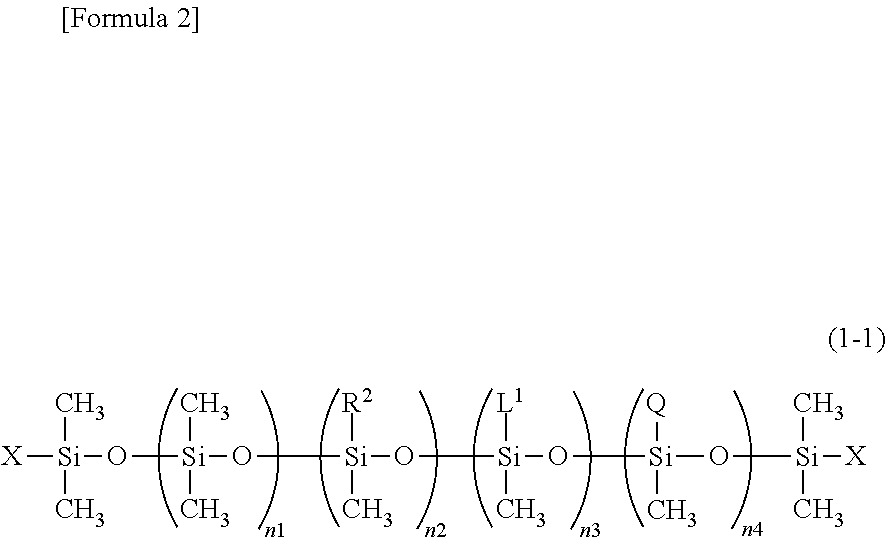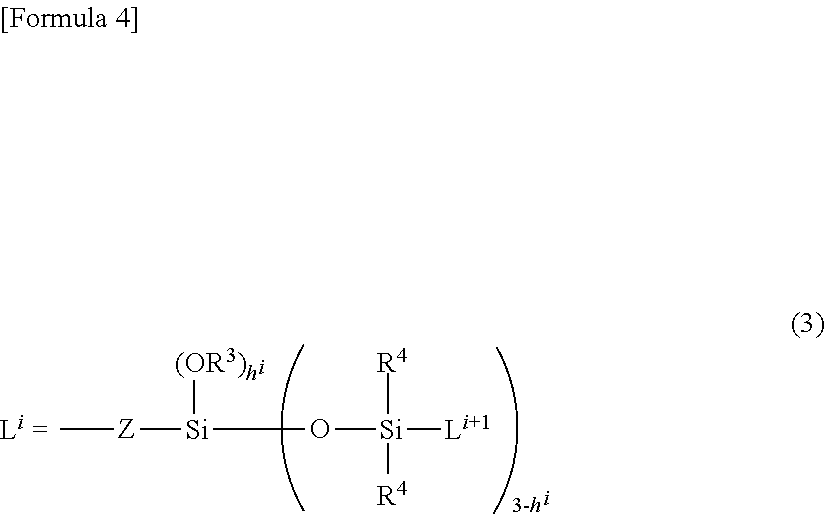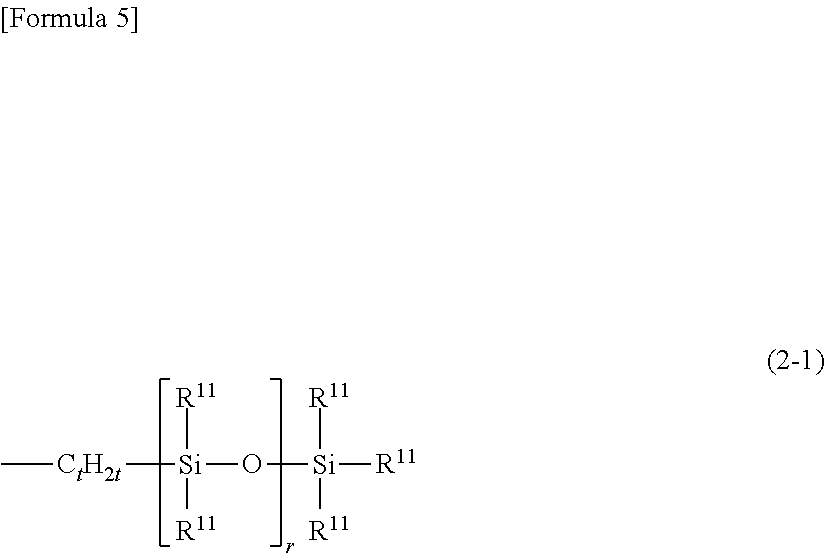Novel organopolysiloxane or acid neutralization salt thereof, and uses of these
- Summary
- Abstract
- Description
- Claims
- Application Information
AI Technical Summary
Benefits of technology
Problems solved by technology
Method used
Image
Examples
example 40 to 45
esis of Silicone Compound According to Present Invention
[0338]In addition to the silicone compounds No. 1 to 13 described above, an epoxy modified silicones with different polymerization degrees (DP) were synthesized, the silicone compound according to the present invention was synthesized through ring-opening reaction between the epoxy modified silicone and a secondary amine compound having a hydroxyl group (diethanolamine (DEA) or diisopropanolamine (DIPA)). Note that “Me” represents a methyl group, “M” represents a Me3SiO group (or an Me3Si group), “D” represents an Me2SiO group, “MH” represents an HMe2SiO group (or an HMeSSi group), “DH” represents an HMe2SiO group, and “MAGE” or “DAGE” represents an epoxy modified unit obtained by reacting allyl glycidyl ether with silicon atom-bonded hydrogen atom of MH or DH.
[Synthesis of Terminal Epoxy Modified Siloxane (MAGED98MAGE) with Polymerization Degree of 100]
[0339]96.42 g of poly dimethyl siloxane with a molecular chain terminal hav...
example 40
ng Reaction with Diethanolamine (DEA)
[0340]52.53 g of the terminal epoxy modified siloxane (MAGED98MAGE) with a polymerization degree of 100, 1.2 g of diethanolamine. And 30 g of IPA were placed in the 3 neck flask, and were heated to 75° C. The reaction solution was held for 23 hours at 75° C., and the ring-opening reaction was performed. After the reaction, the IPA was removed from the solution using through a four hour operation of a rotary evaporator (water bath at 80° C., and reduced pressure of 3 mbar). As a result, tertiary-amine structure-containing polyhydric alcohol modified silicone (denoted by M*D98M*) with a polymerization degree of 100, and with both siloxane chain terminals having a functional group described later. Only a trace amount of IPA was detected.
[0341]Note that “M” denotes
a monosiloxy unit represented by SiO(CH3)2{C3H6O—CH2CH(OH)CH2—N(CH2CH2OH)2}.
example 41
ng Reaction with Diisopropanolamine (DIPA)
[0342]51.50 g of the terminal epoxy modified siloxane (MAGED98MAGE) with a polymerization degree of 100, 1.81 g of diisopropanolamine, and 35 g of IPA were placed in the 3 neck flask, and were heated to 75° C. The solution was held for 48 hours at 75° C., and the ring-opening reaction was performed. After the reaction, the IPA was removed from the solution through simple distillation (no pressure reduction) at 90° C. for three hours. As a result, tertiary-amine structure-containing polyhydric alcohol modified silicone (denoted by M**DM*98*) with a polymerization degree of 100, and with both siloxane chain terminals having a functional group described later. Only a trace amount of IPA was detected. Note that “M**”
denotes a monosiloxy unit represented by SiO(CH3)2{C3H6O—CH2CH(OH)CH2—N{CH2CH(CH3)—OH}2}.
[Synthesis of MD381DAGE7.5M]
[0343]97.3 g of methyl hydrogen polysiloxane (denoted by MD381DH7.5M) and 3.40 g of allyl glycidyl ether were placed...
PUM
| Property | Measurement | Unit |
|---|---|---|
| Temperature | aaaaa | aaaaa |
| Volume | aaaaa | aaaaa |
| Volume | aaaaa | aaaaa |
Abstract
Description
Claims
Application Information
 Login to View More
Login to View More - R&D
- Intellectual Property
- Life Sciences
- Materials
- Tech Scout
- Unparalleled Data Quality
- Higher Quality Content
- 60% Fewer Hallucinations
Browse by: Latest US Patents, China's latest patents, Technical Efficacy Thesaurus, Application Domain, Technology Topic, Popular Technical Reports.
© 2025 PatSnap. All rights reserved.Legal|Privacy policy|Modern Slavery Act Transparency Statement|Sitemap|About US| Contact US: help@patsnap.com



